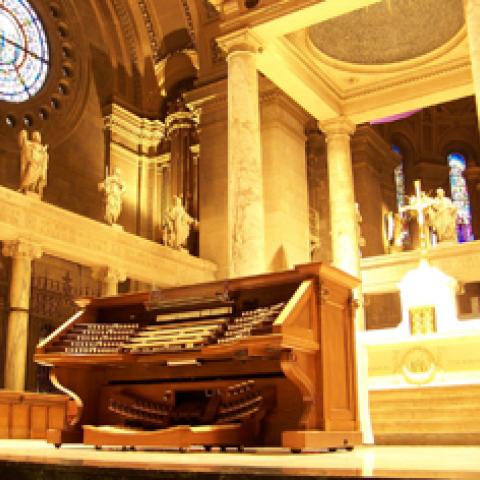The Basilica of Saint Mary, Co-Cathedral of the Archdiocese of Saint Paul-Minneapolis, will host a year-long series of organ concerts and events to celebrate the 65th anniversary of the dedication of its "Centennial" organ. The series begins 15 October 2015 and runs through 15 October 2016. The Basilica's "Centennial" organ is so-named due its coincidental inauguration during the centennial of the foudning of the Saint Paul-Minneapolis Archdiocese.
The Wicks organ, Opus 3047, was built in Highland, Illinois and bears several notable tonal influences by Henry Vincent Willis IV. The instrument presently contains nearly 5,000 pipes in 82 ranks across 6 divisions, playable from a newly built 4-manual console executed in the French-terraced style.
The series' inaugural concert takes place on Thursday, 15 October 2015 at 8:00pm and commemorates the exact date and time of its dedication 65 years ago--8:00pm, 15 October 1950. Former and current Basilica organists Kim Kasling, Christopher Stroh, and Robert Vickery will perform the series' inaugural concert, featuring works from the 1950 program that Mario Salvador originally played. Works include Bach's Toccata and Fugue in d-minor; Dupre's Prelude and Fugue in g-minor; the Allegro from Widor's Symphony 6.
Concert series highlights include the Three Chorales of Cesar Franck in an 8 November 2015 2:30pm concert commemorating the 125th Anniversary of his death. On 15 April 2016, at 7:30pm, the University of Northern Iowa will perform in concert the entire choral works of Maurice Durufle, including several selections of Durufle's solo organ works. The concert series will conclude on 15 Octobert 2015 with an 8:00pm concert featuring solo organ as well as mixed organ, choral, and brass works performed by The Basilica Cathedral Choir and Brass, under the direction of Teri Larson, and Basilica Organist Christopher Stroh.
All concerts are free and open to the public. Free will donations will be gratefully received. For more information, please visit The Basilica website at www.mary.org or inquire directly via email to: cstroh@mary.org.




